![]()
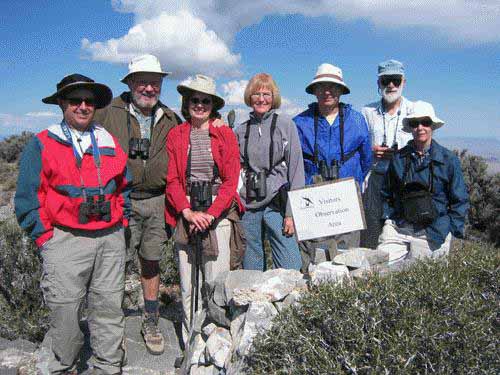 On
Saturday, October 2, 2004, seven Great Salt Lake Audubon members visited the
Hawkwatch International raptor counting and banding site atop the Goshute
Mountain Range in Nevada south of Wendover. Participants included Tony Morgan,
Jim & Judy Bailey, Kathy Coleman, Bill Anderson, and Charles & Allene Keller.
On
Saturday, October 2, 2004, seven Great Salt Lake Audubon members visited the
Hawkwatch International raptor counting and banding site atop the Goshute
Mountain Range in Nevada south of Wendover. Participants included Tony Morgan,
Jim & Judy Bailey, Kathy Coleman, Bill Anderson, and Charles & Allene Keller.
We all met in Wendover at 8am to caravan to the Goshute trailhead, about a 45 minute drive from Wendover. Most men in the group were there for the hike and to see the hawks; they took off on the trail at an aerobic pace, not to be seen until lunchtime on the top. It reminded Judy and me of why we no longer hike with the Wasatch Mountain Club. As much as we enjoy hiking, we have found that we miss a lot of birds along the way if we don't take the time to move slow, stop occasionally, and listen for the birds. Also, if I'm lucky, an avian photo op will present itself.
At the top, weather was warm and sunny, with spectacular views of desert scenery in all directions, including Pilot Peak to the north, the Ruby Range to the west, Wheeler Peak to the south, and the Great Salt Lake Desert to the east.
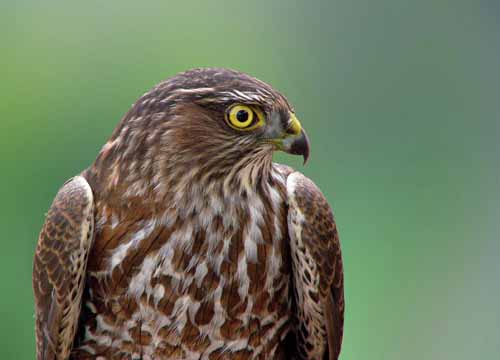 Devon Batley, a Hawkwatch volunteer, greeted us at the site and
educated us on the operation. Volunteers come up to the site in late August and
camp there throughout the migration until October 31. Peak migration, in terms
of number of raptors counted flying overhead, is in late September. With desert on both sides, the
north-south running Goshute range is a natural flyway for the
raptors, providing thermals to lessen their effort during migration.
Devon Batley, a Hawkwatch volunteer, greeted us at the site and
educated us on the operation. Volunteers come up to the site in late August and
camp there throughout the migration until October 31. Peak migration, in terms
of number of raptors counted flying overhead, is in late September. With desert on both sides, the
north-south running Goshute range is a natural flyway for the
raptors, providing thermals to lessen their effort during migration.
While we were there enjoying lunch, we observed Cooper's Hawks, Sharp-shinned Hawks, Red-tailed Hawks, Swainson's Hawks, and Golden Eagles. Devon shared the finer points of hawk identification, which can be tricky as many fly so high, they are mere specks to the naked eye. They frequently travel in kettles, or migratory groups, where they tend to share the same thermals along the way.
Job titles on the mountain include Public Relations (Devon), Counting, Trapping, and Banding. The typical day-to-day staff is 11 people. On the day we were there, a visiting group of trappers were receiving training. This was unfortunate for us, as we were unable to observe the trapping and banding that Judy & I have seen on previous trips.
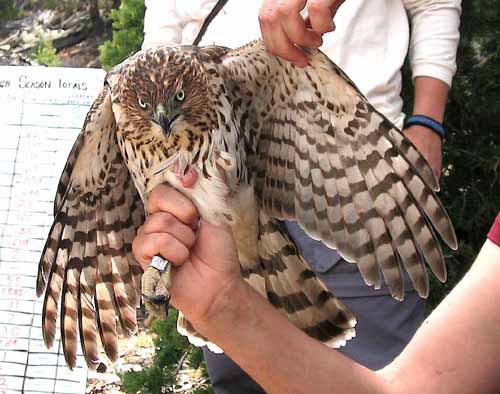 In the counting operation, one or two counters, with good
(young) eyesight and powerful binoculars, constantly scan the skies, identifying
the number of different species and their location in the sky as they migrate
south. These people are a wiz at IDing these birds from afar, often able to call
them out from flight characteristics and general shape alone. As the spotters
shout out what they see, another person keeps the tally.
In the counting operation, one or two counters, with good
(young) eyesight and powerful binoculars, constantly scan the skies, identifying
the number of different species and their location in the sky as they migrate
south. These people are a wiz at IDing these birds from afar, often able to call
them out from flight characteristics and general shape alone. As the spotters
shout out what they see, another person keeps the tally.
In the trapping operation, nets are set up and a live bird is used as the bait. Birds used for bait include Rock Pigeons and House Sparrows, not your most lovable species. The birds are tethered to a stake out in the open on the ridge where they can be easily be spotted by hungry raptors flying closer to the ridge. Trappers hide in a blind where they can oversee the operation and spring the trap on the unsuspecting raptor. Typically, the bait is unscathed, but, on occasion, accidents do happen. To minimize the chance of injuries to the "bait bird", the trappers fit it with a talon-proof vest. After the raptors are captured, they are stuffed into a tube of appropriate size for the bird. This has a calming effect on the captured birds, and they don't make a fuss while in the tubes.
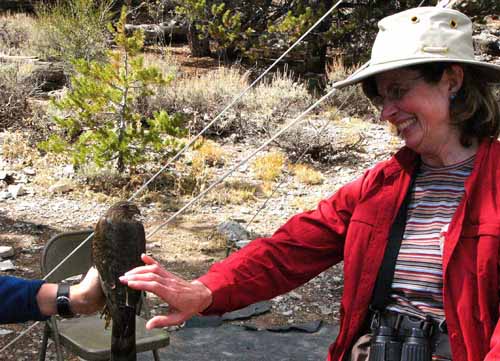 In
the banding operation, the birds are banded, weighed, measured, and blood
sampled. Occasionally, on larger trapped species such as Northern Goshawk or
Golden Eagle, the banders will fit the bird with a tiny radio transmitter backpack with
nylon straps to hold it on without interfering with the bird's ability to fly.
The bird's migratory route can then be tracked using Global Positioning System
(GPS) technology for up to 15 months before the batteries run down.
In
the banding operation, the birds are banded, weighed, measured, and blood
sampled. Occasionally, on larger trapped species such as Northern Goshawk or
Golden Eagle, the banders will fit the bird with a tiny radio transmitter backpack with
nylon straps to hold it on without interfering with the bird's ability to fly.
The bird's migratory route can then be tracked using Global Positioning System
(GPS) technology for up to 15 months before the batteries run down.
While we casually enjoyed our lunches and observed the birds fly overhead and below us, Devon offered tips on raptor identification. Later, we were also able to observe banded birds close up (in hand) prior to their release.
The birds we saw in hand were all young ones, looking for an easy meal. Older birds, for the most part, seem to know better and pass up the "free lunch".
The accipiter first year birds are easy to tell because of their striped breasts and yellow eyes. The eye color changes to red after a year. Red-tail Hawk first year birds are easy to identify, as they do not have red tails until the second year.
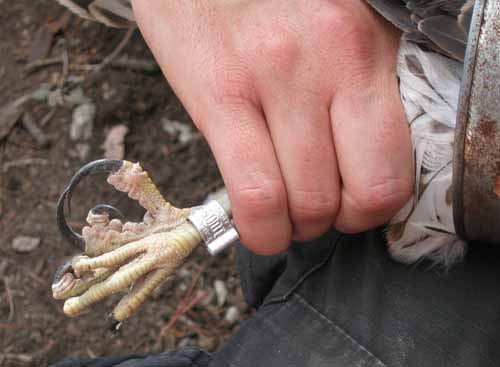 The preponderance of birds captured and banded are first year
birds. Less than one percent of birds captured have bands, indicating that these
birds don't particularly enjoy the experience of getting trapped. They
subsequently learn to avoid this particular ridge of the Goshute's after only one unpleasant visit
to the banding station.
The preponderance of birds captured and banded are first year
birds. Less than one percent of birds captured have bands, indicating that these
birds don't particularly enjoy the experience of getting trapped. They
subsequently learn to avoid this particular ridge of the Goshute's after only one unpleasant visit
to the banding station.
At the trailhead on the way back, Judy and I met two Banders coming off the mountain. They felt bad when we told them we weren't allowed to observe the trapping, counting, and banding operations while our group was there, especially when considering that we are National Audubon Society members who generally support what Hawkwatch International does.
It was a pleasant outing, and all had a good time, but, frankly, my wife and I were disappointed. When we've made this trek in the past, the experience of seeing the full operation has made the long drive from Salt Lake and strenuous hike worthwhile. Much of the information presented in this report is based on past trips we have made. I apologize to participants on this trip if their expectations were not fully met.
Jim Bailey, October 7, 2004